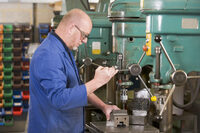 It takes a keen eye to spot all of the dangers associated with manufacturing. After all, not every hazard is obvious to the casual observer.
It takes a keen eye to spot all of the dangers associated with manufacturing. After all, not every hazard is obvious to the casual observer.
Because complacency in manufacturing can be deadly, workers should be well-trained and always on the lookout for hidden dangers. They should also be well equipped to respond to newly spotted dangers — whether that means making repairs on the spot or simply deterring other workers until the problem can be fixed. Below are five hazards that often go unnoticed until it is too late.
1. Electricity: It’s one of the least visible dangers in manufacturing, and it’s one of the most common culprits in workplace fatalities, according to the U.S. Department of Labor’s Occupational Safety & Health Administration (OSHA). Manufacturing facilities are full of wires and cables that should be routinely inspected for tears, cracks and exposed fibres. Kinks and undue pressure should also be reduced whenever possible. To reduce risk, manufacturers should be sure they are using the right equipment: antimicrobial cables in high-moisture environments like food manufacturing; chemical- or heat-resistant cables to reduce the risk of corrosion or heat exposure; fire-resistant cables in proximity to ovens, A/C equipment, furnaces and other appliances. Anyone working in the vicinity of electrical cables should have access to protective gloves.
2. Fire: A fire can ignite without much warning. Once it spreads, it can be too late to prevent serious injuries or death. If you and your employees know what to look for, you can stop a fire before it starts. Be sure engines are clear of flammable materials and that any welding equipment is safety stored and frequently inspected. And as mentioned above, your electrical equipment should be well maintained and checked often. Regardless of your preventative measures, be sure you are equipped with easily accessible fire extinguishers and multiple smoke detectors. As fire can cause panic that only makes a situation worse, be sure your employees have practised fire response. Post instructions throughout your facility to direct them to safety, as well as any relevant phone numbers. Make sure all safety equipment is well marked, and use multiple languages when necessary.
3. Gas: It’s an invisible threat that can result in suffocation or explosion. Often times, it is odourless. Because it is so hard to detect without the right equipment, gas is one of the most menacing of all hidden manufacturing dangers. A manufacturing facility should be equipped with a gas detection system that can alert workers to a wide range of noxious gases, including carbon monoxide, nitrogen dioxide, hydrogen and various other natural gases. Workers should be trained to notice the signs associated with gas exposure (dizziness or headache, for example) both for themselves and for their co-workers. Your facility should be equipped with respiratory protection if the threat of gas is high enough to prevent workers from quickly escaping it.
4. Confined spaces: Confined spaces aren’t necessarily hidden, but your workers might not be familiar with the risks, making such settings very dangerous. Working within a confined space may be routine for some employees and rare occasions for others, but all should be aware of the risks. Workers can become trapped and unable to call out for help, or they can be at risk of suffocation. Your facility should be equipped with exhaust blowers and other types of ventilation to prevent the latter. And anyone working within a confined space should have a partner on the outside so that a dangerous situation doesn’t go unnoticed. Be sure to have the necessary equipment on hand (winches and harnesses, for example) to extract someone who is trapped or unconscious.
5. Poorly maintained equipment: They are out in the open, but to the untrained eye, they’re invisible. The hazards related to poorly maintained industrial equipment can be tricky to identify until it’s too late. Each piece of machinery in your facility should be inspected at regular intervals. Likewise, the employees who operate them should be trained to spot anything out of the ordinary. You should also pay close attention to manufacturers’ recall notice in case a piece of your machine is more likely to malfunction.
When you know where to look, you can find and eliminate many manufacturing risks. And with the right equipment and training, you can operate a much safer facility.
About the author:
Carol Sabovik is the Marketing Manager of TPC Wire & Cable Corp. in Macedonia, OH. TPC Wire & Cable is a leading wire and cable manufacturer that supplies industrial components used in harsh environments, such as composite cables, cable assemblies and electrical components. TPC’s products are designed and engineered to withstand harsh conditions including abrasion, chemicals, and extreme temperatures.